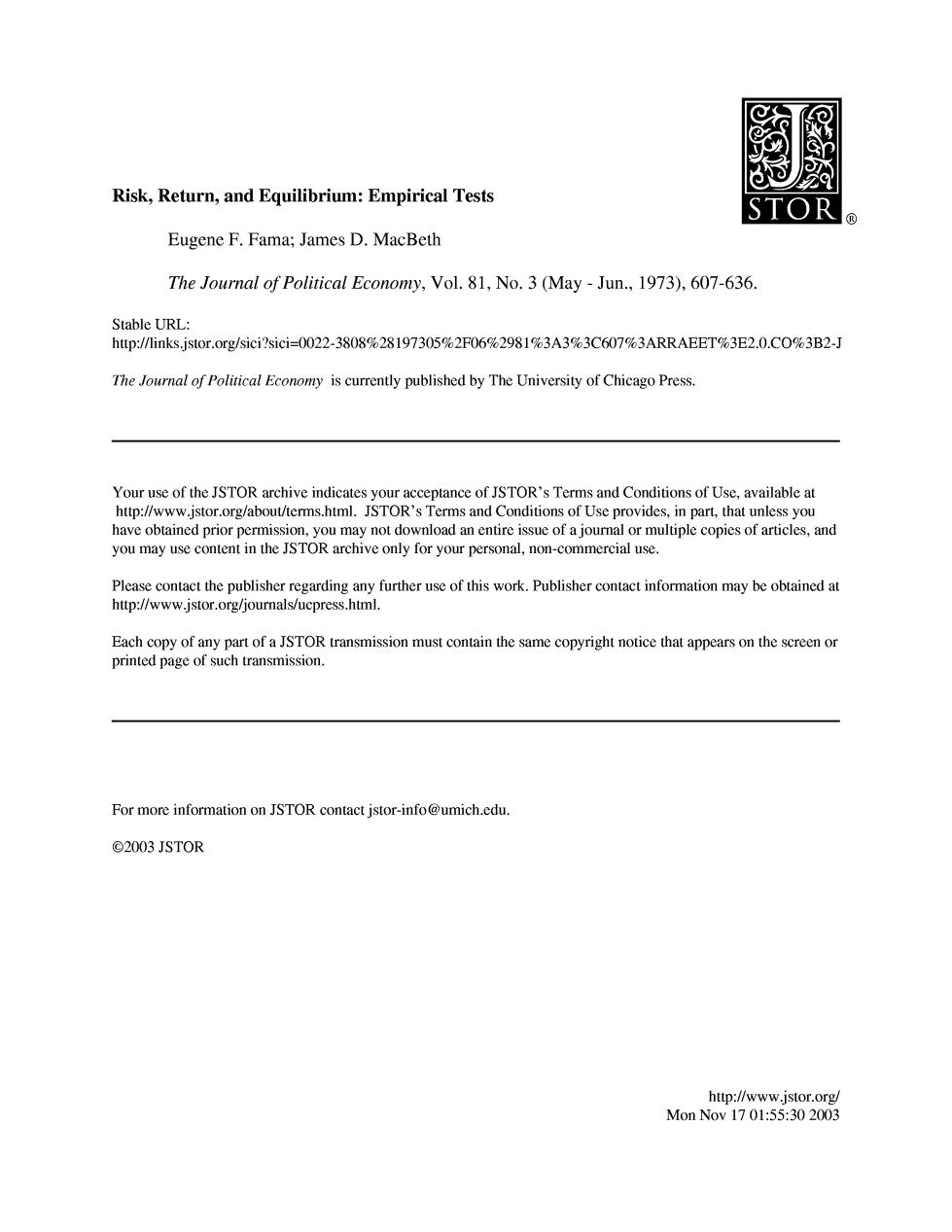
Risk,Return,and Equilibrium:Empirical Tests STOR ® Eugene F.Fama;James D.MacBeth The Journal of Political Economy,Vol.81,No.3 (May -Jun.,1973),607-636. Stable URL: http://links.jstor.org/sici?sici=0022-3808%28197305%2F06%2981%3A3%3C607%3ARRAEET%3E2.0.CO%3B2-J The Journal of Political Economy is currently published by The University of Chicago Press. Your use of the JSTOR archive indicates your acceptance of JSTOR's Terms and Conditions of Use,available at http://www.jstor.org/about/terms.html.JSTOR's Terms and Conditions of Use provides,in part,that unless you have obtained prior permission,you may not download an entire issue of a journal or multiple copies of articles,and you may use content in the JSTOR archive only for your personal,non-commercial use. Please contact the publisher regarding any further use of this work.Publisher contact information may be obtained at http://www.jstor.org/journals/ucpress.html. Each copy of any part of a JSTOR transmission must contain the same copyright notice that appears on the screen or printed page of such transmission. For more information on JSTOR contact jstor-info@umich.edu. ©2003 JSTOR http://www.jstor.org/ Mon Nov1701:55:302003
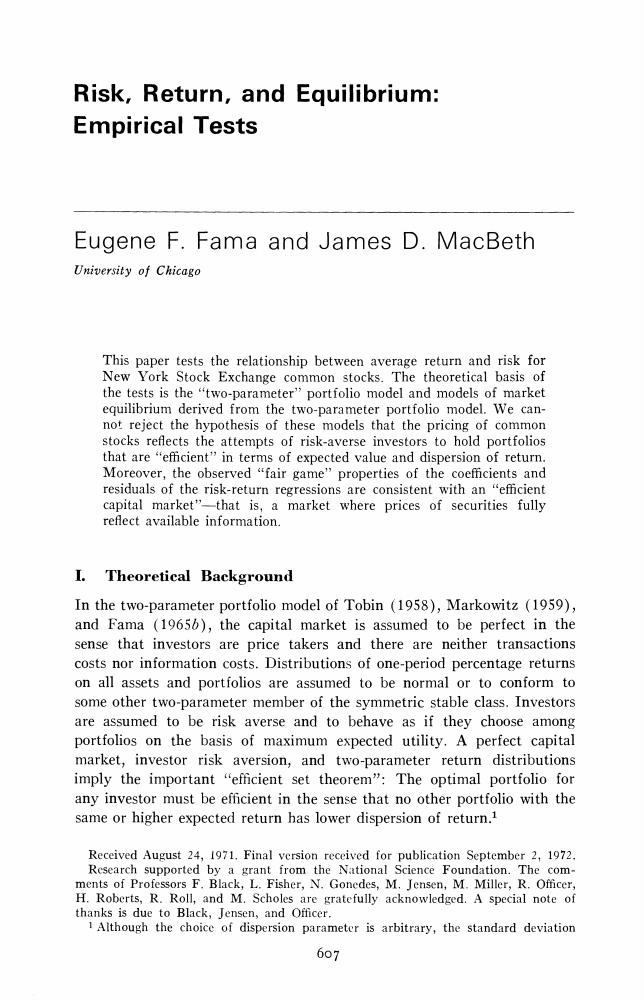
Risk,Return,and Equilibrium: Empirical Tests Eugene F.Fama and James D.MacBeth University of Chicago This paper tests the relationship between average return and risk for New York Stock Exchange common stocks.The theoretical basis of the tests is the "two-parameter"'portfolio model and models of market equilibrium derived from the two-parameter portfolio model.We can- not reject the hypothesis of these models that the pricing of common stocks reflects the attempts of risk-averse investors to hold portfolios that are "efficient"in terms of expected value and dispersion of return. Moreover,the observed "fair game"properties of the coefficients and residuals of the risk-return regressions are consistent with an "efficient capital market"-that is,a market where prices of securities fully reflect available information. I.Theoretical Background In the two-parameter portfolio model of Tobin (1958),Markowitz (1959), and Fama (19656),the capital market is assumed to be perfect in the sense that investors are price takers and there are neither transactions costs nor information costs.Distributions of one-period percentage returns on all assets and portfolios are assumed to be normal or to conform to some other two-parameter member of the symmetric stable class.Investors are assumed to be risk averse and to behave as if they choose among portfolios on the basis of maximum expected utility.A perfect capital market,investor risk aversion,and two-parameter return distributions imply the important "efficient set theorem":The optimal portfolio for any investor must be efficient in the sense that no other portfolio with the same or higher expected return has lower dispersion of return.1 Received August 24,1971.Final version received for publication September 2,1972. Research supported by a grant from the National Science Foundation.The com- ments of Professors F.Black,L.Fisher,N.Gonedes,M.Jensen,M.Miller,R.Officer, H.Roberts,R.Roll,and M.Scholes are gratefully acknowledged.A special note of thanks is due to Black,Jensen,and Officer. I Although the choice of dispersion parameter is arbitrary,the standard deviation 607
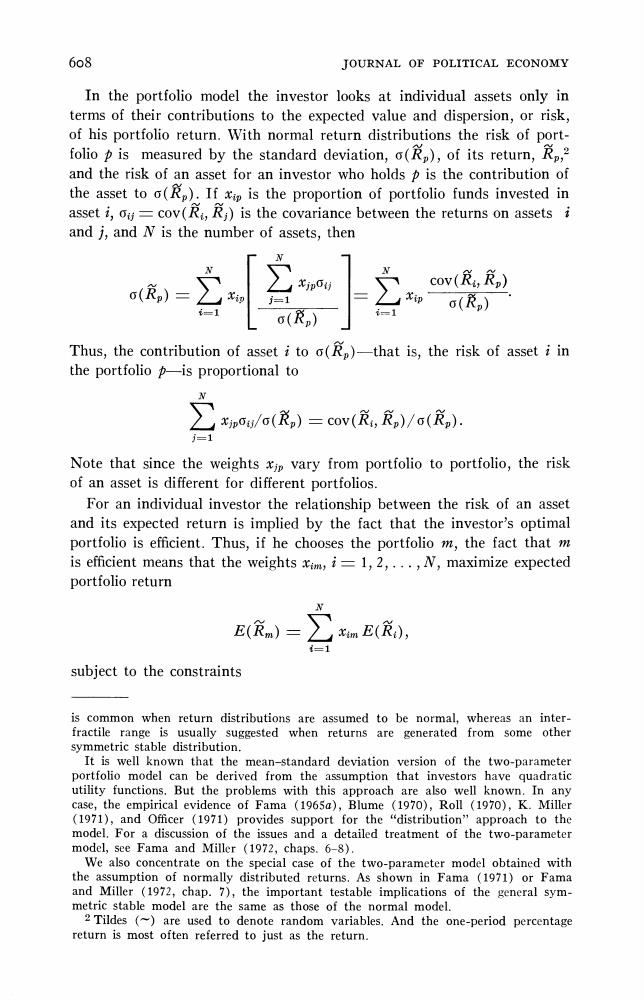
6o8 JOURNAL OF POLITICAL ECONOMY In the portfolio model the investor looks at individual assets only in terms of their contributions to the expected value and dispersion,or risk, of his portfolio return.With normal return distributions the risk of port- folio is measured by the standard deviation,()of its return,p,? and the risk of an asset for an investor who holds is the contribution of the asset to (R).If is the proportion of portfolio funds invested in asset i,oy=cov(Rj)is the covariance between the returns on assets i and j,and N is the number of assets,then (成,)= cov(Ri,R) () (R) Thus,the contribution of asset i to o(Rp)-that is,the risk of asset i in the portfolio pis proportional to xjpag/a(Rp)=cov(Ri,Rp)/a(Rp). j=1 Note that since the weights ip vary from portfolio to portfolio,the risk of an asset is different for different portfolios. For an individual investor the relationship between the risk of an asset and its expected return is implied by the fact that the investor's optimal portfolio is efficient.Thus,if he chooses the portfolio m,the fact that m is efficient means that the weightsx,=1,2,...,N,maximize expected portfolio return E(nm) xmE(), subject to the constraints is common when return distributions are assumed to be normal,whereas an inter- fractile range is usually suggested when returns are generated from some other symmetric stable distribution. It is well known that the mean-standard deviation version of the two-parameter portfolio model can be derived from the assumption that investors have quadratic utility functions.But the problems with this approach are also well known.In any case,the empirical evidence of Fama (1965a),Blume (1970),Roll (1970),K.Miller (1971),and Officer (1971)provides support for the "distribution"approach to the model.For a discussion of the issues and a detailed treatment of the two-parameter model,see Fama and Miller (1972,chaps.6-8). We also concentrate on the special case of the two-parameter model obtained with the assumption of normally distributed returns.As shown in Fama (1971)or Fama and Miller (1972,chap.7),the important testable implications of the general sym- metric stable model are the same as those of the normal model. 2 Tildes (~are used to denote random variables.And the one-period percentage return is most often referred to just as the return

RISK,RETURN,AND EQUILIBRIUM 609 o(p)=o(rm)and ∑m=1 i Lagrangian methods can then be used to show that the weights xim must be chosen in such a way that for any asset i in m E(范)一E(n)=Sm (1) where Sm is the rate of change of E(Rp)with respect to a change in (R)at the point on the efficient set corresponding to portfolio If there are nonnegativity constraints on the weights (that is,if short selling is prohibited),then (1)only holds for assets i such that xim>0. Although equation (1)is just a condition on the weights xim that is re- quired for portfolio efficiency,it can be interpreted as the relationship be- tween the risk of asset i in portfolio i and the expected return on the asset. The equation says that the difference between the expected return on the asset and the expected return on the portfolio is proportional to the differ- ence between the risk of the asset and the risk of the portfolio.The pro- portionality factor is Sm,the slope of the efficient set at the point corres- ponding to the portfolio m.And the risk of the asset is its contribution to total portfolio risk,(m). II.Testable Implications Suppose now that we posit a market of risk-averse investors who make portfolio decisions period by period according to the two-parameter model.3 We are concerned with determining what this implies for observable properties of security and portfolio returns.We consider two categories of implications.First,there are conditions on expected returns that are im- plied by the fact that in a two-parameter world investors hold efficient portfolios.Second,there are conditions on the behavior of returns through time that are implied by the assumption of the two-parameter model that the capital market is perfect or frictionless in the sense that there are neither transactions costs nor information costs. A.Expected Returns The implications of the two-parameter model for expected returns derive from the efficiency condition or expected return-risk relationship of equa- tion (1).First,it is convenient to rewrite (1)as 3A multiperiod version of the two-parameter model is in Fama (1970a)or Fama and Miller (1972,chap.8)
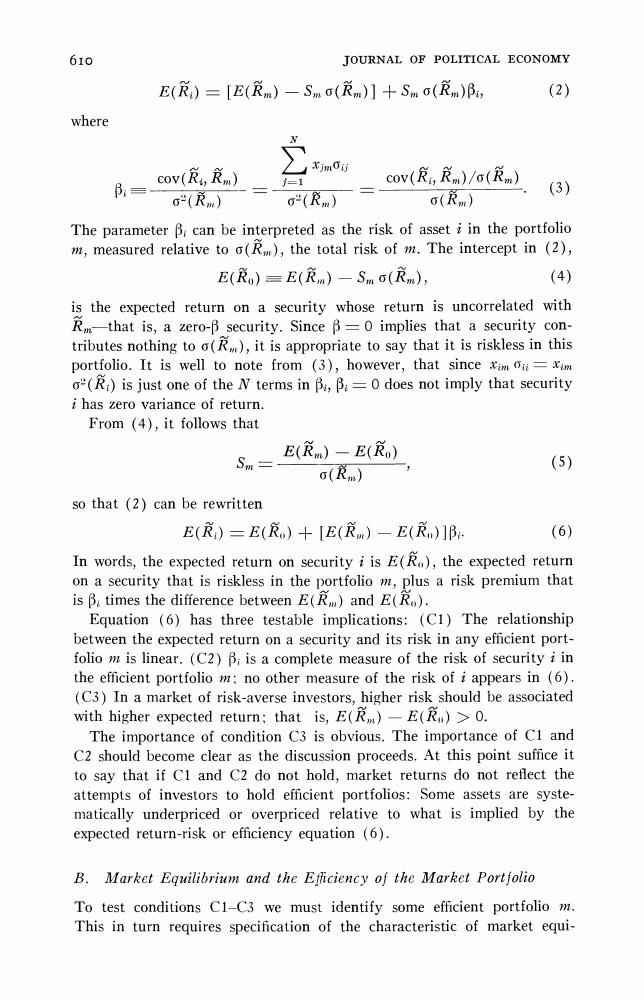
610 JOURNAL OF POLITICAL ECONOMY E(R)=[E(Rm)一Smo(Rm】十Smo(Rm)B, (2) where cov(Ri,R) XjmGij =1 cov(r,哀m)/o(n) (3) 2(Rm) a2(Rm) o(Rm) The parameter B.can be interpreted as the risk of asset i in the portfolio m,measured relative to (R),the total risk of m.The intercept in (2), E()=E(m)一SmG(m), (4) is the expected return on a security whose return is uncorrelated with R-that is,a zero-B security.Since B=0 implies that a security con- tributes nothing to (Rm),it is appropriate to say that it is riskless in this portfolio.It is well to note from (3),however,that since xim oi=xam o2(R)is just one of the N terms in Bi,B=0 does not imply that security i has zero variance of return. From (4),it follows that Sm= E(R)一E(Ro) a(Rm) (5) so that (2)can be rewritten E(R)=E()+[E(Rm)-E()]B: (6) In words,the expected return on security i is E(R),the expected return on a security that is riskless in the portfolio m,plus a risk premium that is B:times the difference between E(R)and E(Ro). Equation (6)has three testable implications:(C1)The relationship between the expected return on a security and its risk in any efficient port- folio m is linear.(C2)B;is a complete measure of the risk of security i in the efficient portfolio m:no other measure of the risk of i appears in (6). (C3)In a market of risk-averse investors,higher risk should be associated with higher expected return:that is,E(R)-E(R)>0. The importance of condition C3 is obvious.The importance of C1 and C2 should become clear as the discussion proceeds.At this point suffice it to say that if C1 and C2 do not hold,market returns do not reflect the attempts of investors to hold efficient portfolios:Some assets are syste- matically underpriced or overpriced relative to what is implied by the expected return-risk or efficiency equation (6). B.Market Equilibrium and the Efficiency of the Market Portjolio To test conditions C1-C3 we must identify some efficient portfolio m. This in turn requires specification of the characteristic of market equi-
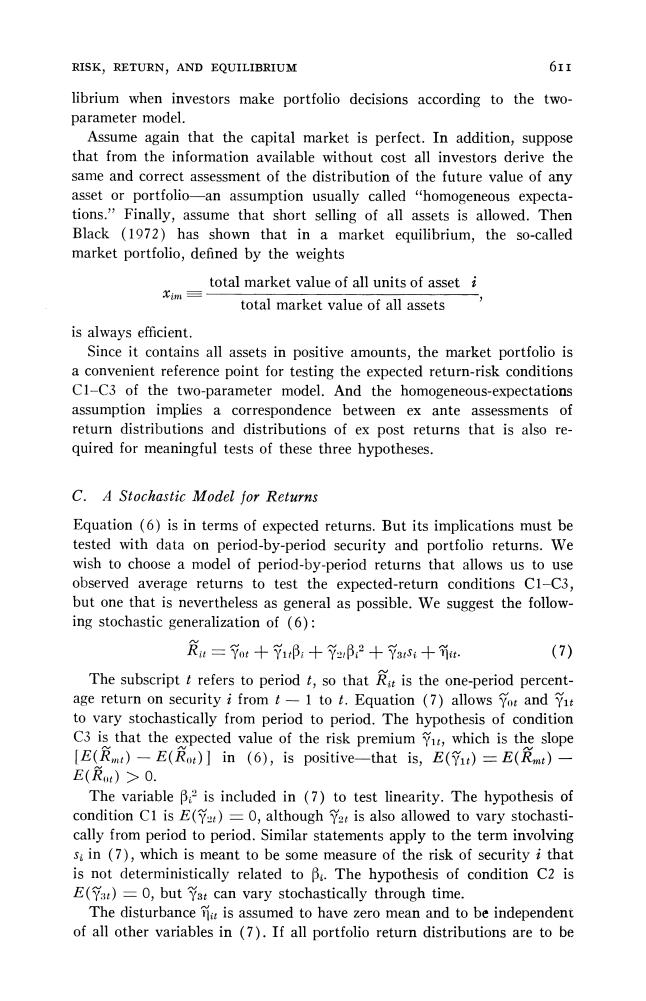
RISK,RETURN,AND EQUILIBRIUM 611 librium when investors make portfolio decisions according to the two- parameter model. Assume again that the capital market is perfect.In addition,suppose that from the information available without cost all investors derive the same and correct assessment of the distribution of the future value of any asset or portfolio-an assumption usually called "homogeneous expecta- tions."Finally,assume that short selling of all assets is allowed.Then Black (1972)has shown that in a market equilibrium,the so-called market portfolio,defined by the weights total market value of all units of asset i xim三 total market value of all assets is always efficient. Since it contains all assets in positive amounts,the market portfolio is a convenient reference point for testing the expected return-risk conditions C1-C3 of the two-parameter model.And the homogeneous-expectations assumption implies a correspondence between ex ante assessments of return distributions and distributions of ex post returns that is also re- quired for meaningful tests of these three hypotheses. C.A Stochastic Model for Returns Equation(6)is in terms of expected returns.But its implications must be tested with data on period-by-period security and portfolio returns.We wish to choose a model of period-by-period returns that allows us to use observed average returns to test the expected-return conditions C1-C3, but one that is nevertheless as general as possible.We suggest the follow- ing stochastic generalization of (6): a=ot+71B:+Yβ:2+7s+it. (7) The subscript t refers to period t,so that R is the one-period percent- age return on security i from t-1 to t.Equation (7)allows yot and Yit to vary stochastically from period to period.The hypothesis of condition C3 is that the expected value of the risk premium,which is the slope [E(Rmt)-E(Rot)in (6),is positive-that is,E()=E(Rit)- E()>0. The variable Bis included in (7)to test linearity.The hypothesis of condition C1 is E()=0,although 2 is also allowed to vary stochasti- cally from period to period.Similar statements apply to the term involving s in (7),which is meant to be some measure of the risk of security i that is not deterministically related to B.The hypothesis of condition C2 is E(Yat)=0,but Yat can vary stochastically through time. The disturbance ne is assumed to have zero mean and to be independent of all other variables in (7).If all portfolio return distributions are to be
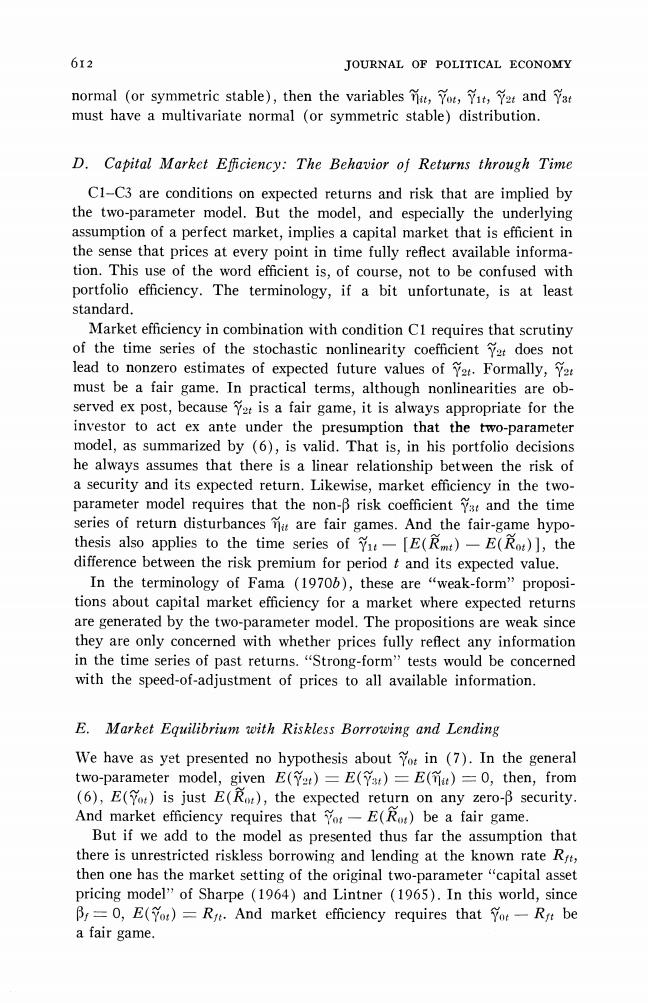
612 JOURNAL OF POLITICAL ECONOMY normal (or symmetric stable),then the variables n,Tot,Yt,and Yat must have a multivariate normal (or symmetric stable)distribution. D.Capital Market Eficiency:The Behavior of Returns through Time C1-C3 are conditions on expected returns and risk that are implied by the two-parameter model.But the model,and especially the underlying assumption of a perfect market,implies a capital market that is efficient in the sense that prices at every point in time fully reflect available informa- tion.This use of the word efficient is,of course,not to be confused with portfolio efficiency.The terminology,if a bit unfortunate,is at least standard. Market efficiency in combination with condition Cl requires that scrutiny of the time series of the stochastic nonlinearity coefficient ya does not lead to nonzero estimates of expected future values of Y2t.Formally, must be a fair game.In practical terms,although nonlinearities are ob- served ex post,becauseis a fair game,it is always appropriate for the investor to act ex ante under the presumption that the two-parameter model,as summarized by (6),is valid.That is,in his portfolio decisions he always assumes that there is a linear relationship between the risk of a security and its expected return.Likewise,market efficiency in the two- parameter model requires that the non-B risk coefficient Yat and the time series of return disturbances Ta are fair games.And the fair-game hypo- thesis also applies to the time series of Y-[E(R)-E(Rot)],the difference between the risk premium for period t and its expected value. In the terminology of Fama (19706),these are "weak-form"proposi- tions about capital market efficiency for a market where expected returns are generated by the two-parameter model.The propositions are weak since they are only concerned with whether prices fully reflect any information in the time series of past returns."Strong-form"tests would be concerned with the speed-of-adjustment of prices to all available information. E.Market Equilibrium with Riskless Borrowing and Lending We have as yet presented no hypothesis about Yo in (7).In the general two-parameter model,given E()=E()=E(n)=0,then,from (6),E(T)is just E(Rot),the expected return on any zero-B security. And market efficiency requires that Yr-E(Rot)be a fair game. But if we add to the model as presented thus far the assumption that there is unrestricted riskless borrowing and lending at the known rate Rst, then one has the market setting of the original two-parameter "capital asset pricing model"of Sharpe (1964)and Lintner (1965).In this world,since Bs=0,E(Yo)=Rst.And market efficiency requires that Yot-Rrt be a fair game
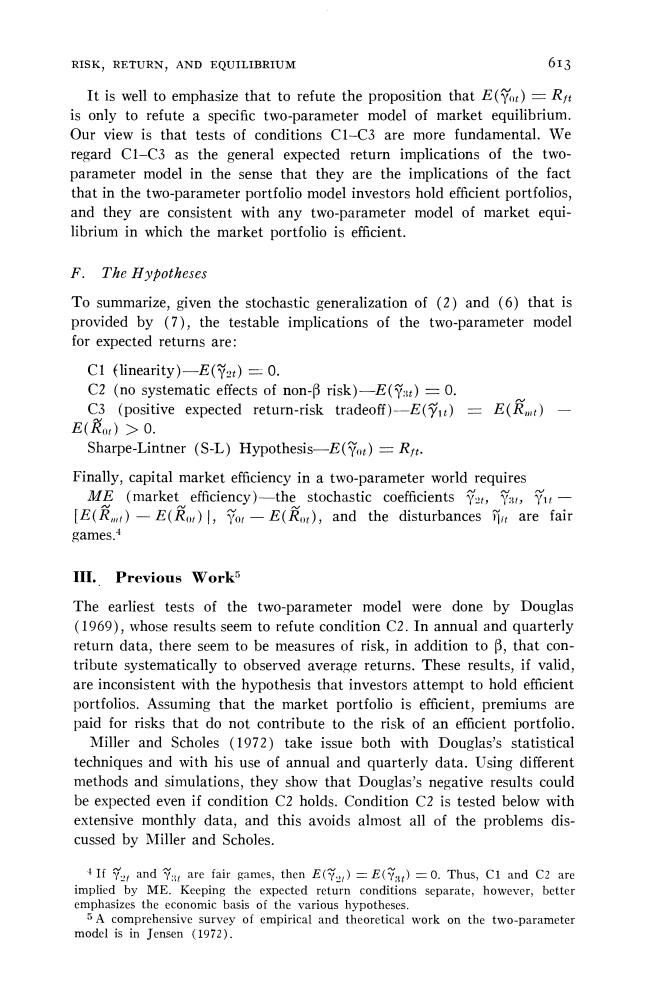
RISK,RETURN,AND EQUILIBRIUM 613 It is well to emphasize that to refute the proposition that E(Yot)=Ryt is only to refute a specific two-parameter model of market equilibrium. Our view is that tests of conditions C1-C3 are more fundamental.We regard C1-C3 as the general expected return implications of the two- parameter model in the sense that they are the implications of the fact that in the two-parameter portfolio model investors hold efficient portfolios, and they are consistent with any two-parameter model of market equi- librium in which the market portfolio is efficient. F.The Hypotheses To summarize,given the stochastic generalization of (2)and (6)that is provided by (7),the testable implications of the two-parameter model for expected returns are: C1 (linearity)-E(Y2t)=0. C2 (no systematic effects of non-B risk)-E()=0. C3 (positive expected return-risk tradeoff)-E()=E()- E(驳r)>0. Sharpe-Lintner (S-L)Hypothesis-E(Yot)=Rst. Finally,capital market efficiency in a two-parameter world requires ME (market efficiency)-the stochastic coefficients,,- [E(R)-E(Ror)1,Yor-E(Rot),and the disturbances fit are fair games.4 III.Previous Work The earliest tests of the two-parameter model were done by Douglas (1969),whose results seem to refute condition C2.In annual and quarterly return data,there seem to be measures of risk,in addition to B,that con- tribute systematically to observed average returns.These results,if valid, are inconsistent with the hypothesis that investors attempt to hold efficient portfolios.Assuming that the market portfolio is efficient,premiums are paid for risks that do not contribute to the risk of an efficient portfolio Miller and Scholes (1972)take issue both with Douglas's statistical techniques and with his use of annual and quarterly data.Using different methods and simulations,they show that Douglas's negative results could be expected even if condition C2 holds.Condition C2 is tested below with extensive monthly data,and this avoids almost all of the problems dis- cussed by Miller and Scholes. 4 If and are fair games,then E()=E(Ya)=0.Thus,C1 and C2 are implied by ME.Keeping the expected return conditions separate,however,better emphasizes the economic basis of the various hypotheses. 5 A comprehensive survey of empirical and theoretical work on the two-parameter model is in Jensen (1972)
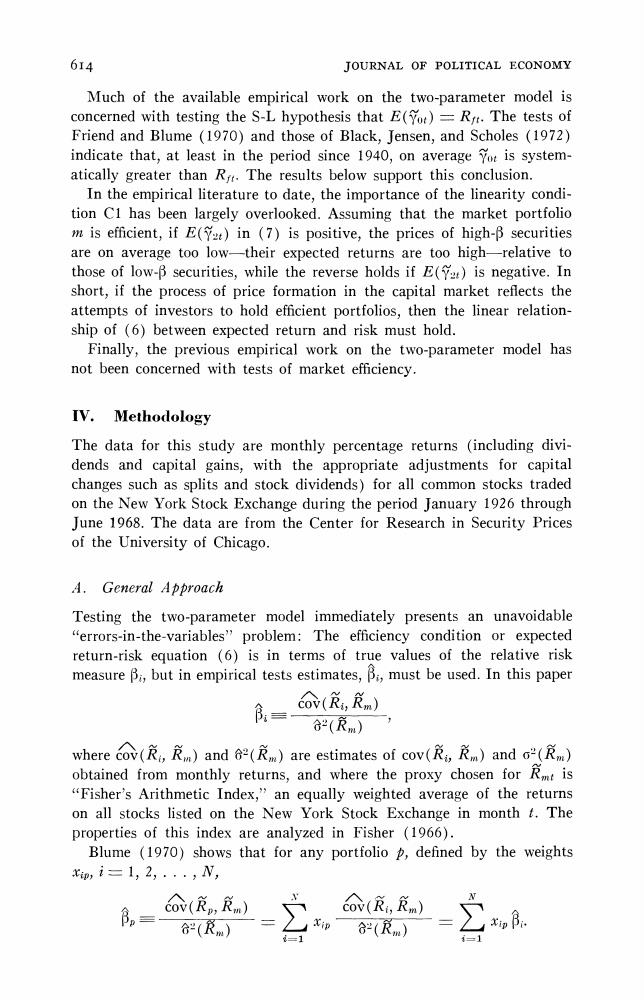
614 JOURNAL OF POLITICAL ECONOMY Much of the available empirical work on the two-parameter model is concerned with testing the S-L hypothesis that E(Y)=Rs.The tests of Friend and Blume (1970)and those of Black,Jensen,and Scholes (1972) indicate that,at least in the period since 1940,on average To is system- atically greater than R.The results below support this conclusion. In the empirical literature to date,the importance of the linearity condi- tion CI has been largely overlooked.Assuming that the market portfolio m is efficient,if E()in (7)is positive,the prices of high-B securities are on average too low-their expected returns are too high-relative to those of low-B securities,while the reverse holds if E()is negative.In short,if the process of price formation in the capital market reflects the attempts of investors to hold efficient portfolios,then the linear relation- ship of (6)between expected return and risk must hold. Finally,the previous empirical work on the two-parameter model has not been concerned with tests of market efficiency. IV.Methodology The data for this study are monthly percentage returns (including divi- dends and capital gains,with the appropriate adjustments for capital changes such as splits and stock dividends)for all common stocks traded on the New York Stock Exchange during the period January 1926 through June 1968.The data are from the Center for Research in Security Prices of the University of Chicago. A.General Approach Testing the two-parameter model immediately presents an unavoidable "errors-in-the-variables"problem:The efficiency condition or expected return-risk equation (6)is in terms of true values of the relative risk measure Bi,but in empirical tests estimates,Bi,must be used.In this paper (,m) 三 2(m) where(R,n)and()are estimates of cov(,飞n)ando(之m) obtained from monthly returns,and where the proxy chosen for Rm is "Fisher's Arithmetic Index,"an equally weighted average of the returns on all stocks listed on the New York Stock Exchange in month t.The properties of this index are analyzed in Fisher (1966). Blume (1970)shows that for any portfolio defined by the weights p,i=1,2,.,·,N, (R,n) 6(Rm) =1 xipRm) 1
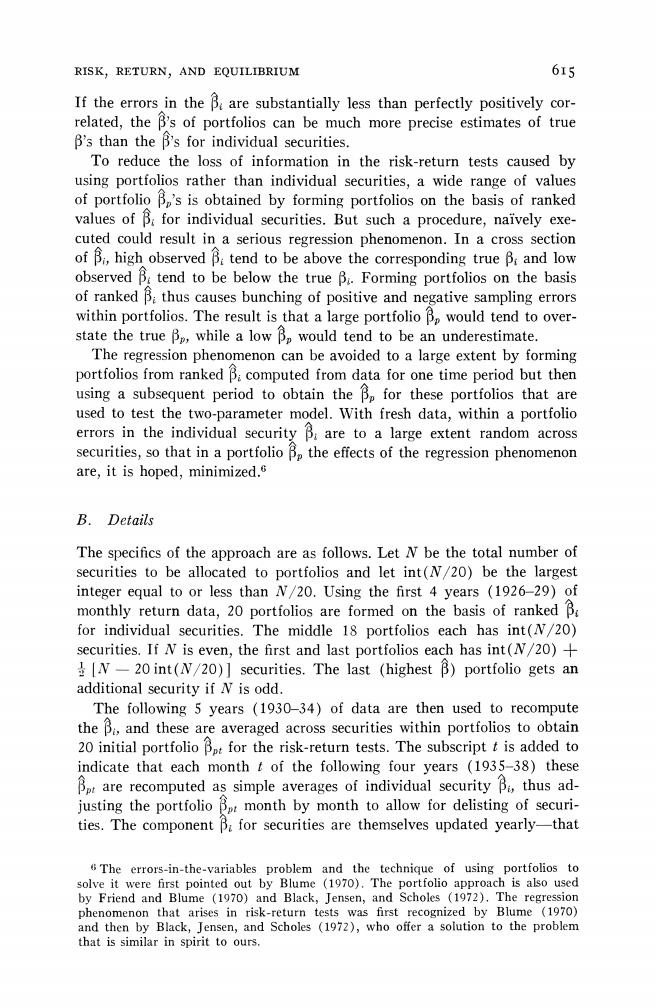
RISK,RETURN,AND EQUILIBRIUM 615 If the errors in the B are substantially less than perfectly positively cor- related,the B's of portfolios can be much more precise estimates of true B's than the B's for individual securities. To reduce the loss of information in the risk-return tests caused by using portfolios rather than individual securities,a wide range of values of portfolio B's is obtained by forming portfolios on the basis of ranked values of B:for individual securities.But such a procedure,naively exe- cuted could result in a serious regression phenomenon.In a cross section of Bi,high observed B.tend to be above the corresponding true B:and low observed B:tend to be below the true B.Forming portfolios on the basis of ranked B:thus causes bunching of positive and negative sampling errors within portfolios.The result is that a large portfolio B would tend to over- state the true B,while a low B would tend to be an underestimate. The regression phenomenon can be avoided to a large extent by forming portfolios from ranked B:computed from data for one time period but then using a subsequent period to obtain the Bp for these portfolios that are used to test the two-parameter model.With fresh data,within a portfolio errors in the individual security B:are to a large extent random across securities,so that in a portfolio Bp the effects of the regression phenomenon are,it is hoped,minimized.6 B.Details The specifics of the approach are as follows.Let N be the total number of securities to be allocated to portfolios and let int(N/20)be the largest integer equal to or less than N/20.Using the first 4 years (1926-29)of monthly return data,20 portfolios are formed on the basis of ranked B for individual securities.The middle 18 portfolios each has int(N/20) securities.If N is even,the first and last portfolios each has int(N/20) IN-20 int(N/20)]securities.The last (highest B)portfolio gets an additional security if N is odd. The following 5 years (1930-34)of data are then used to recompute the B,and these are averaged across securities within portfolios to obtain 20 initial portfolio for the risk-return tests.The subscript t is added to indicate that each month t of the following four years (1935-38)these Bare recomputed as simple averages of individual security Bi,thus ad- justing the portfolio Bot month by month to allow for delisting of securi- ties.The component B:for securities are themselves updated yearly-that 6The errors-in-the-variables problem and the technique of using portfolios to solve it were first pointed out by Blume (1970).The portfolio approach is also used by Friend and Blume (1970)and Black,Jensen,and Scholes (1972).The regression phenomenon that arises in risk-return tests was first recognized by Blume (1970) and then by Black,Jensen,and Scholes (1972),who offer a solution to the problem that is similar in spirit to ours